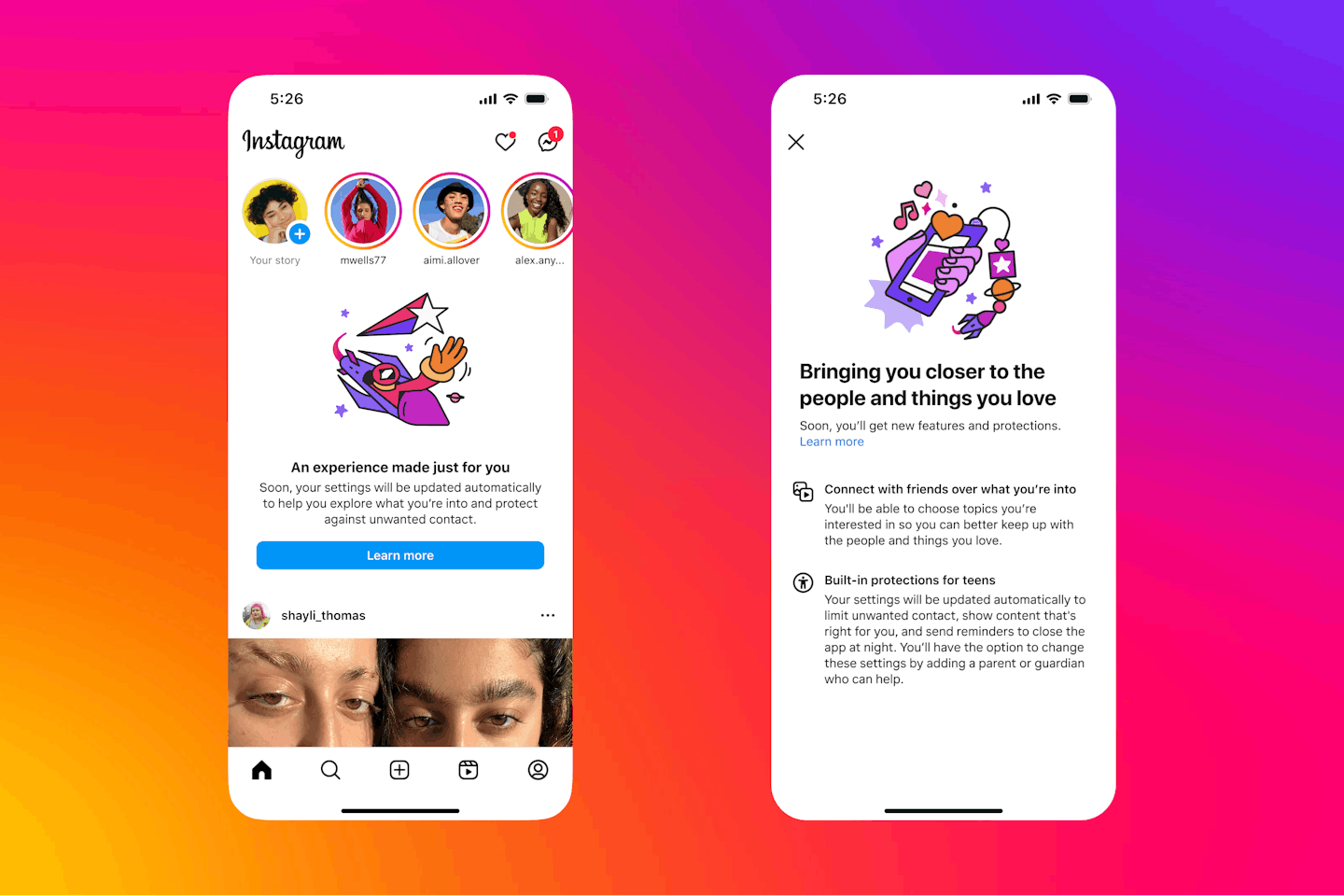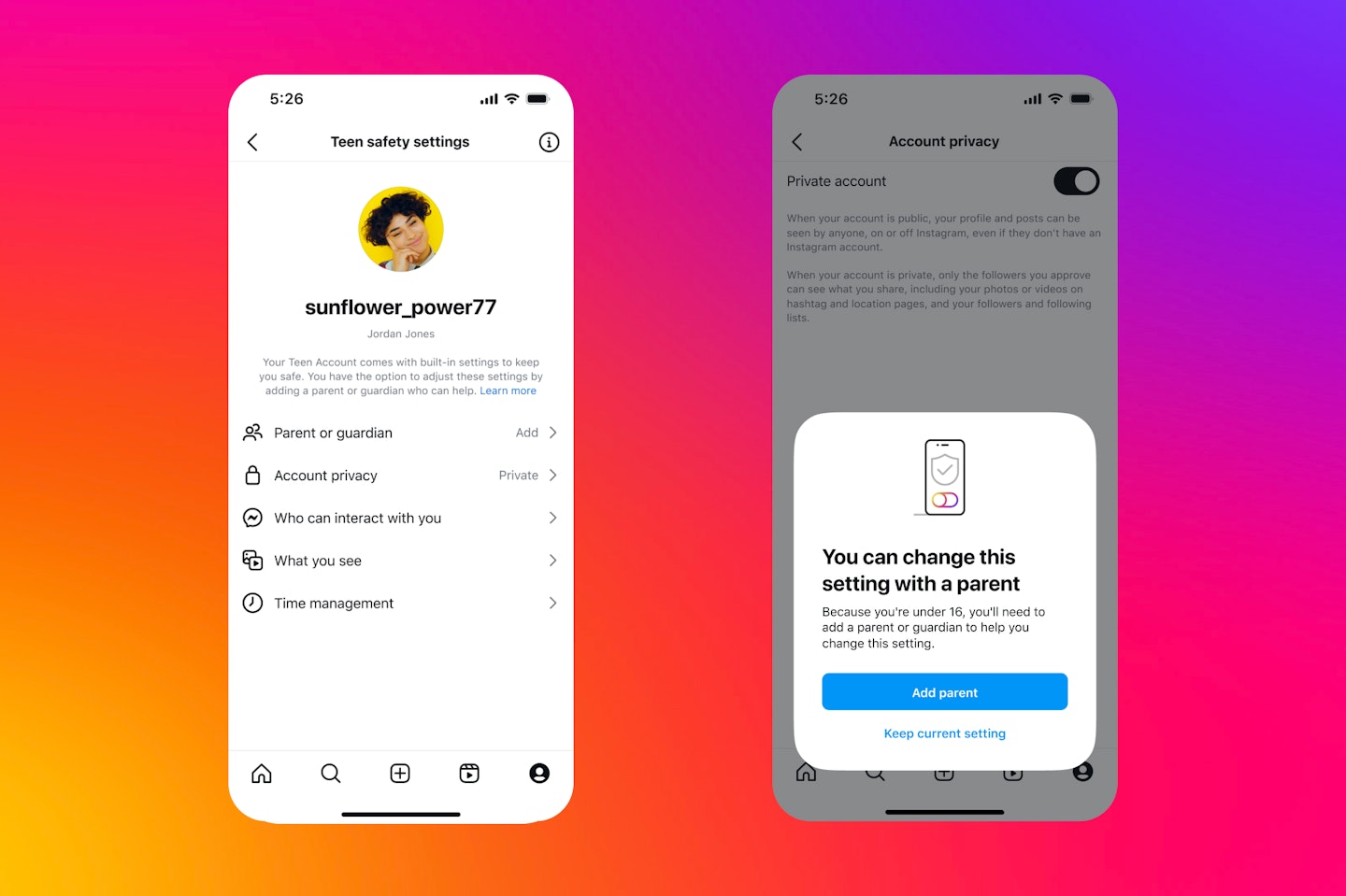Instagram has announced the launch of a new experience for users under the age of 18. Today, 17th September, they will roll out ‘Teen Accounts’, which means anyone under 18 will see their account automatically put into the ‘Teen’ bracket where their default settings will change in an effort to better protect them when using social media.
The move comes after years of debate around the impact of social media on young people. Parents have long expressed their concerns about children’s exposure to social media – and now, after months of consultation with parenting and safety groups, Instagram is changing the way young people use the app and importantly giving more reassurance to parents.
To find out more about what Teen Accounts is and how it will impact the way young people use Instagram, we sat down with Instagram’s global policy director Tara Hopkins…
GRAZIA: Why is Instagram launching Teen Accounts?
TARA HOPKINS: We're constantly iterating, building new tools over the last five to ten years to keep people, particularly young people, safe on Instagram. We've done a huge amount of research on this, and we did hear from parents that the number of tools and features available to them, while appreciated, can be quite overwhelming. Between school admin, the numerous WhatsApp groups, and their teens being on many social media or messaging apps all at the same time, it can feel really overwhelming for parents to know how to manage that.
So, with Teen Accounts, we're trying to take the onus off the parents by automatically defaulting teens into Teen Accounts without the parent having to do anything. We are trying to answer the three biggest concerns that parents told us that they have on Instagram, which is who their teen is contacting, the content that they are seeing and the time that they're spending on their phones and whether that is time well spent.
G: What are Teen Accounts?
TH: It’s not a new app! Teen Accounts mean that every teen under the age of 18 is going to be defaulted into a Teen Account experience. 'Teen Accounts have built-in protections which limit who can contact them and the content they see,' explains Instagram. 'They also provide more ways to connect with friends and explore their interests. Teens under 16 won’t be able to change any of these settings to be less strict without getting a parent’s permission to do so. These changes will apply to teens already using Instagram and to teens signing up to the app.'
In practice, that means the following default settings on their account:
-
Private accounts: With private accounts on, teens need to accept new followers, and people who don’t follow them can’t see their content or interact with them.
-
Messaging restrictions: Teens will be placed in the strictest messaging defaults, meaning that they can only be messaged by people they follow or are connected to.
-
Sensitive content restrictions: Teens will automatically be placed into the “Show Less” setting of our Sensitive Content Control, which restricts the type of content teens see in places like Explore and Reels.
-
Limited interactions: Teens can only be tagged or mentioned by people they follow. We'll also automatically turn on the most restrictive version of our anti-bullying feature, Hidden Words, so that offensive words and phrases will be filtered out of teens’ comments and DM requests.
-
Time limit reminders: Teens will be encouraged to leave the app after 60 minutes each day.
-
Sleep mode enabled: Sleep Mode will be turned on between 10PM and 7AM, which will mute notifications overnight and send auto-replies to DMs.

G: What will happen to teens with existing accounts?
TH: From 17th of September, we will be defaulting anyone who's the age of 18 into a teen account experience. If the young person is already using Instagram, they will see a notification explaining to them what the teen account experience is.
Older teens can change their settings if they choose to, but if the teen is under the age of 16, they are going to have to get their parent or guardian’s permission to change any of those defaults by setting up a ‘supervisor’.

We've differentiated between younger teens (those between the ages of 13 and 15) and older teens (aged 16-17) through research and focus groups that we've done because parents and other youth and safety experts recognize the difference in maturity between a 13-year-old and a 17-year-old.
G: What about teen influencers on the app?
TH: We do recognise absolutely that teens, whether they are creators or campaigners or activists, use Instagram for lots of different reasons. We're giving all teens advanced warning of the change, but creators will get a little bit of extra time to be able to understand what this means for their account and how to make sure that the defaults are working for them. A lot of those teen creators are older teens, and so they will be able to change their default settings if they're over the age of 16.
How does the parental supervisor tool work, could teens just have their friends be set up as one?
We've thought long and hard about this. You have to be over the age of 18 to ‘supervise’ a teen on Instagram. We don't go so far as to ask for evidence [of them being the parent], like providing a birth certificate, for a few reasons. One is that it feels privacy intrusive, frankly, but also, it's important that we recognize that not every teen is in a traditional family model.
Many teens might be asking an older sibling or an aunt or an uncle to supervise their account. We just want the person supervising the account to be a trusted by the young person and to be a responsible adult. We don't want to restrict that young person, so if they don't have a mum or a dad at home, or they're not in that traditional family setting, they can still ask someone who they're connected and close to that’s over the age of 18, to be in the supervisory tool with them.
The other thing, though, is that it's not mandatory for a teenager to set up the supervision tool. The important thing about Teen Accounts is that we are putting young people into these default settings - and we hope they stay in them because they are that bit more protected- but if they choose to have a public account, for example, they do have to ask their parent or the guardian to give that approval. And hopefully that also creates a conversation between the guardian and the teenager as to why they want that.
Parental supervision also gives parents access to information and tools to oversee and manage their teen’s account (see below).

G: What are the ‘additional ways to connect with friends and explore their interests’?
TH: This is called ‘interest picker’. So, when you're first joining Instagram, it can be a bit overwhelming. So, when you're joining Instagram now, you'll be offered an interest picker, and this is a list of interests from which you can choose as many as you want, and then we will be recommending and serving content and accounts related to specific interests in your first weeks and months on Instagram.
It's really a way for us to better understand what you're interested in and provide you with value. And then, if the teen does choose to set up a supervisor relationship with their parent, that parent will be able to see those interests and they'll be able to have a conversation offline with their young person.

G: What do the sensitive content restrictions stop teens from seeing?
TH: So, it’s important to note that sensitive content control is not about any content that violates our policies – that content is removed from the platform when it’s found or reported to us.
Sensitive content control is about anything that an older teen or an adult might be suitable to view but we certainly wouldn't want to be recommending it to a young person, which is where the age bands comes into this as well. It might be content that has curse words in it or some sexualization. Again, that might be absolutely fine for a 17-year-old or a 25-year-old, but we don't want 13-year-olds to come across that kind of content.
G: With Hidden Words turned on, are they automatically chosen words or do parents need to pick words that will be hidden?
TH: It’s a mixture of both. So, with Teen Accounts the Hidden Words setting is defaulted as on and that tool is already built into the app and includes words and phrases that we've worked with a lot of organizations - from safety, youth, misinformation and disinformation - to make sure that the right kind of words are in there. But the great thing about hidden words is that you can add to it. So, whether you're a teen or adults, you can go into the hidden words feature, and you can add anything that might be contextual for you. It might be a phrase you find offensive or a name you’ve been called in the past, and you can add that to hidden words, so you won't see anything, and you won’t be tagged in anything if that word is being used.
G: Have you trialled the feature with parents already and if so, what has been the feedback?
TH: We’ve been working with parents for many, many months on Teen Accounts through researchers, focus groups and our Youth Advisory board which is made up of organisations like Parent Zone. During consultation we’ve had great feedback, but it'll be over the next 60 days, as it rolls out, that we’ll be constantly looking at how the tool is used, what the experience is, and we'll be iterating on it as we go.

